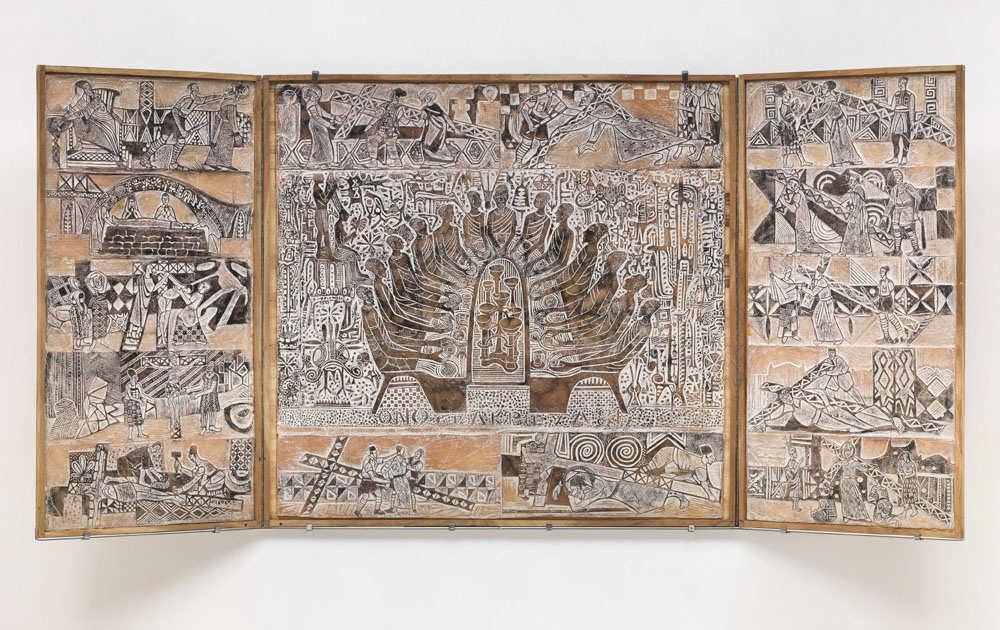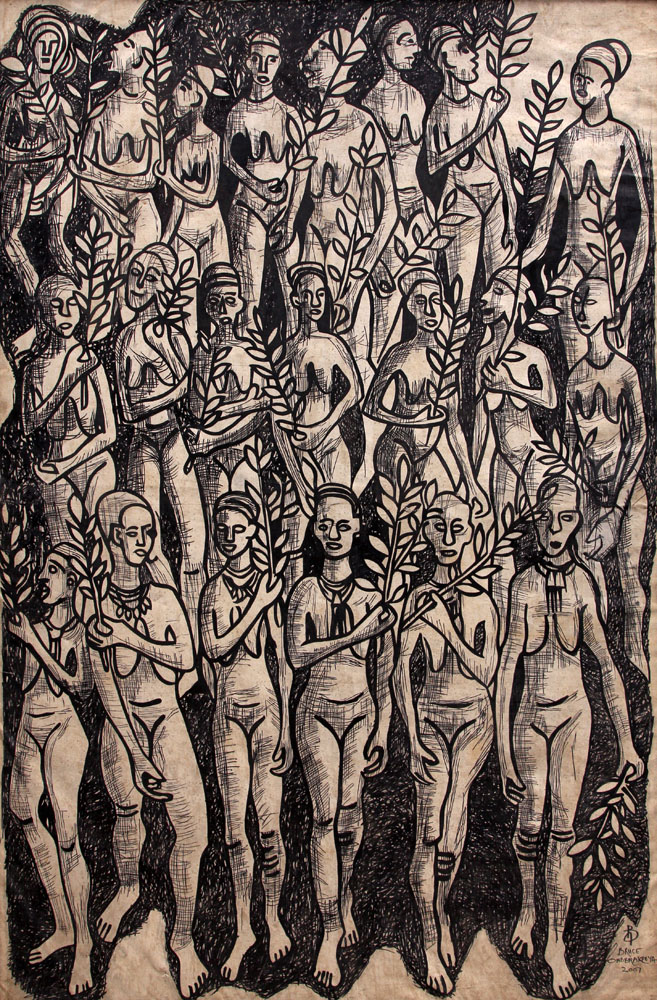The Zaria Arts Society (later Zaria Rebels) forms at Nigerian College of Arts, Science and Technology, with the goal of decolonizing the visual arts while achieving a “natural synthesis” between Western and Nigerian modes of representation. Among the founding members is Onobrakpeya.

Cover of exhibition catalogue. Photo courtesy of the Smithsonian Institute Archives.
First one-man exhibition, Ughelli, Delta State, Nigeria.On October 1, Nigeria is granted full independence from the British government.

Cover of Nigeria Exhibition catalogue
Included in The Nigeria Exhibition to commemorate independence, where the work of the Zaria Art Society, to which Onobrakpeya belongs, is called “the greatest surprise of the exhibition” for their works that synthesize twentieth-century European art with Indigenous modes of representation. Onobrakpeya’s contribution consists of a mural illustrating arts and crafts.
Palm Wine Women, 1965, serigraph. Photo courtesy of SMO Contemporary Art.

Bruce Onobrakpeya, creating a bronze relief. © Juliet Highet. All rights reserved 2023 / Bridgeman Images

Eclipse, 1967, deep etching on paper. National Museum of African Art, Smithsonian Institution, Washington, DC.
Workshops and Experimentation: As an art student in the late 1950s, Onobrakpeya was trained in the academic European methods inherited by the British colonial regime, a pedagogical system that taught compositional proficiency but obscured local modes of visual expression. While he is drawn to artists of the Western tradition, such as French Post-Impressionist Paul Gauguin (1848–1903)—whose style and palette are evident in Onobrakpeya’s painting Palm Wine Women (1965)—he also forges a path toward abstraction that incorporates Nigerian traditions and artistic culture, as in his etching Eclipse (1967). The most important experiences of Onobrakpeya’s early career, however, are in the printmaking workshops he attends in 1963 and 1964—the Mbari, Ibadan, and Mbari-Mbayo, Osogbo—after which he principally begins to work, and innovate, in the mode. His plastographs, a kind of printmaking technique he experiments with in 1967, will become his signature medium and make much of his artwork immediately recognizable.
Frontispiece from No Longer at Ease
Illustrates second edition of Chinua Achebe’s No Longer at Ease (first published in 1960), the second book of the author’s African Trilogy also comprising Things Fall Apart (1958) and later Arrow of God (1964). The commission is one of Onobrakpeya’s earliest published illustrations, and he will go on to provide illustrations for numerous other publications over the subsequent decades.
Station XI: They nail Jesus to the cross, 1969, linoleum block print on rice paper, High Museum of Art, Atlanta, gift of Mr. George A. Naifeh, 2006.228.11.
Christian Themes: Although only about twelve percent of Nigerians consider themselves Catholic—Onobrakpeya not among them—the seat of the delegation of the Holy See for Central and West Africa was transferred to Lagos in 1960, and the Church exercised considerable influence over the country’s artistic milieu during this period. Among the more enterprising and radical clergymen working in Nigeria is Father Kevin Carroll (1920–1993), who through the Society of African Missions establishes art workshops in Nigeria and commissions Onobrakpeya in 1967 to paint a mural of the Fourteen Stations of the Cross for St. Paul’s Church in Lagos. Throughout the rest of his career, Onobrakpeya will juxtapose and blend Christian and Nigerian traditions, both by reinterpreting Biblical scenes through the lens of midcentury decolonization in Nigeria and by adopting and reconfiguring compositions from Western Christian art.

Have you Heard?, 1970, deep etching on paper, National Museum of African Art, Smithsonian Institution, Washington, DC.
The Nigerian Civil War, an armed conflict between the national government of Nigeria and the secessionist Republic of Biafra, representing the Igbo ethnic group, takes place during this period. The war will result in millions of deaths and affect Nigerian artists such as Onobrakpeya, who represents the surrounding cultural and social tensions in his art.
The south wall of the church with the Stations, 2008. Photograph courtesy of Paul Wood.
Executes mural of Fourteen Stations of the Cross for St. Paul’s Church in Ebute Metta, Lagos on commission from Father Kevin Carroll.Included in Contemporary African Arts Festival exhibition at the Field Museum of Natural History in Chicago and the American Museum of Natural History in New York.
Included in exhibition sponsored by African-American Women’s Association, Martin Luther King, Jr. Library, Washington, D.C.
Awarded Pope Paul VI Gold Medal for Life of St. Paul, following an exhibition at the Vatican Museums, Rome.

Afieki I, 1978, deep foil etching on board. Photo courtesy of Bonhams.

Je moto mri ruo ru, 1980, metal engraving mounted on board. Photo courtesy of Bonhams
Symbols of Ancestral Groves: In this period, Onobrakpeya investigates historical civilizations and figures, including from the Benin Kingdom, in his art, while continuing to develop his print and low-relief techniques.
A Group of 4 Panels (Untitled; The Masquerades; Oremu Vbo Ogbo; Emiovbo Beroma), 1984, plastocast relief. Photo courtesy of Sotheby’s.
The Sahelian Masquerades: This series takes its name from the Sahel, a region in North Africa separating the Sahara Desert in the north from the savanna in the south. Onobrakpeya’s work from the period explores the life and iconography of the peoples and cultures of the region—a subject many of the Zaria Rebels favor—as well as the threats to the environment posed by rampant resource exploitation.
The Hydra’s Head, 1980, deep etching on paper, National Museum of African Art, Smithsonian Institution, Washington, DC.
Provides illustrations for book of poems published by Barbara Haegar entitled Africa: On Her Schedule Is Written a Change, including The Hydra’s Head (1980), a work that uses ancient mythology to illustrate the issues facing twentieth-century post-colonial Africa.
The Last Supper, 1981, resin, wood, metal, and paint, Tate Modern, London.
Awarded Lali Katat silver medal at the 5th Indian Triennale in New Delhi for The Last Supper (1981), a triptych of carved plaster panels that reprises his works form the latter 1960s drawing from the artistic traditions of Catholicism.Receives a Certificate of Honor in recognition of distinguished services contributed to the development of Nigerian art awarded by the Council of Management of Asele Institute Nimo, Anambra State, Nigeria.
Sahelian Masquerades exhibition opens at the Italian Cultural Institute in Lagos before touring worldwide—among the venues are Kew Garden, London; Greenwich Citizens Gallery, London; National Gallery of Zimbabwe, Harare; and Gibbes Museum of Art, Charleston, South Carolina.
Awarded Honorary Degree, Doctor of Letters by the University of Ibadan, Nigeria.

Miniature Images Panel III, 1990, plastograph. Photo courtesy of SMO Contemporary Art.

Ekugbe (Unity), 1995, oil on canvas. Photo courtesy of SMO Contemporary Art.
The Mask Series: This period includes both work exploring traditional African masks, and the many ways they can be represented and reinterpreted. Among the formats used in this period are also panels made up on grids of symbols, and sometimes, of scripts the artist invented.Receives Honorable Mention at the 44th Venice Biennale.
Included in the exhibition Contemporary African Artists: Changing Traditions, The Studio Museum in Harlem, New York.
Featured in Bruce Onobrakpeya: A Retrospective, National Museum, Onikan, Lagos, Nigeria.
Featured in The Spirit in Ascent, a large exhibition of his work with an accompanying extensive catalogue.

Nudes and Protest, 1995-2007, oil drawing. Photo courtesy of SMO Contemporary Art.
Protest and the Environment: In 1995, non-violent environmental activist Ken Saro-Wiwa is tried and hanged by a military tribunal, setting off protests around the country and incurring the indignation of much of the world. Always interested in the environment, Onobrakpeya produces images that capture the social movements generated at the time.
Environmental Regeneration, 2005, mixed-media on board. Photo courtesy of Bonhams.

Hunter in the Rain Forest, 2007, mixed-media installation, National Museum of African Art, Smithsonian Institution, Washington, DC.
Installations and Mixed Media Artwork: From the 1990s to the present, Onobrakpeya has worked on multimedia installations, many of which evoke shrines and sites of spirituality, continuing his engagement with Nigerian artistic traditions. The materials used in creating these installations, however—from contemporary craftwork to computer parts—makes them decidedly modern artworks.Work included in Seven Stories About Modern Art in Africa at Whitechapel Gallery, London, part of Africa95, a celebration of African art and culture held throughout the United Kingdom.
Inaugural Harmattan Workshop at Agbarha-Otor—established by the Bruce Onobrakpeya Foundation as a place for collaboration and for the artist’s work, and those of his peers, to be exhibited.
Work included in Century City: Art and Culture in the Modern Metropolis within section titled "(Lagos 1955-1970)" at Tate Modern, London.

Photograph by Don Cole, 2002. Image © courtesy of the Fowler Museum at UCLA
Installation entitled Akporode, exploring Urhobo shrines and traditions, and other works included in Ways of the Rivers: Arts and Environment of the Niger Delta at the UCLA Fowler Museum of Cultural History, Los Angeles.
Installation photograph featuring Urhobo masks alongside, from left to right, Onobrakpeya’s Opha (1973) and I love my wives (Eyame Jevwe) (1982). Photo courtesy of the National Museum of African Art, Smithsonian Institution, Washington, DC.
Work included in exhibition entitled Where Gods and Mortals Meet: Continuity and Renewal in Urhobo Art, which opens at the Museum for African Art in New York and travels to the Columbia Museum of Art, South Carolina and the National Museum of African Art, Smithsonian Institution, Washington, DC.Receives UNESCO Living Human Treasures Award.
Work exhibited at 7th Dakar Biennale (Dak’Art).
Receives Creativity Award from Nigerian government.
Work exhibited at 10th Dakar Biennale (Dak’Art).
Work included in The Art of Translation: The Simon Ottenberg Gift of Modern and Contemporary Nigerian Art at The Newark Museum of Art, New Jersey.
Receives Nigerian National Order of Merit Award (NNOM), the nation’s highest academic honor.
Honored with Grand Master of Etching award.
Turns ninety on August 30.

